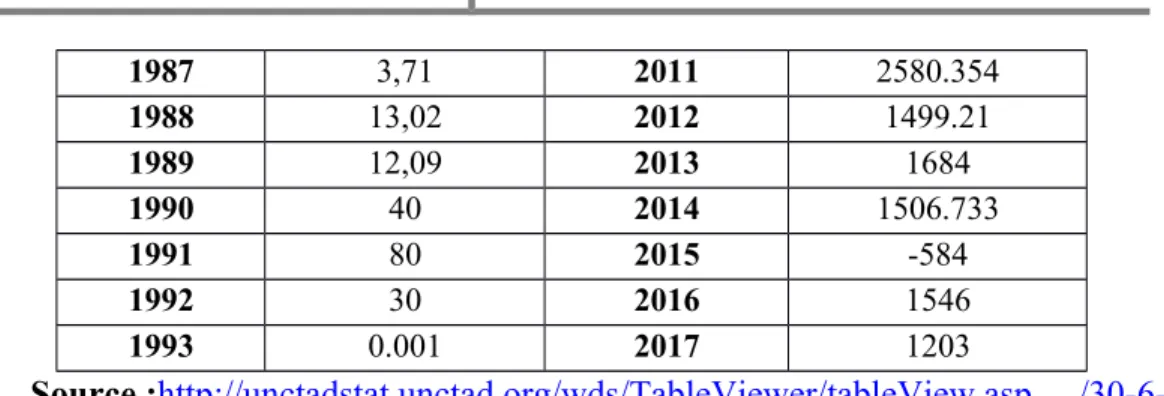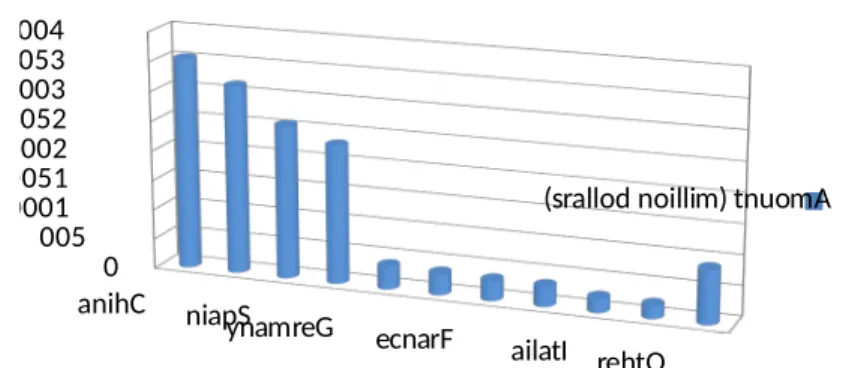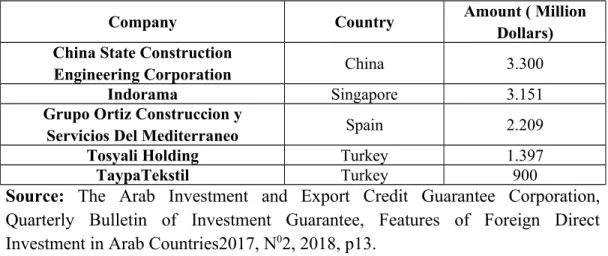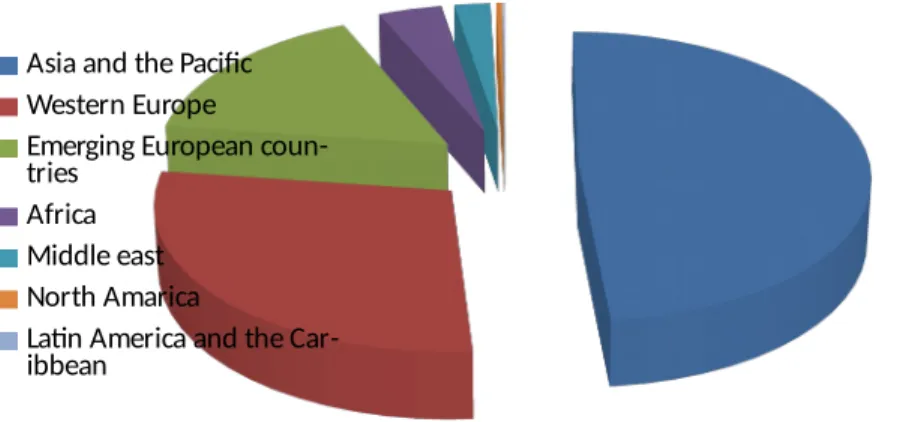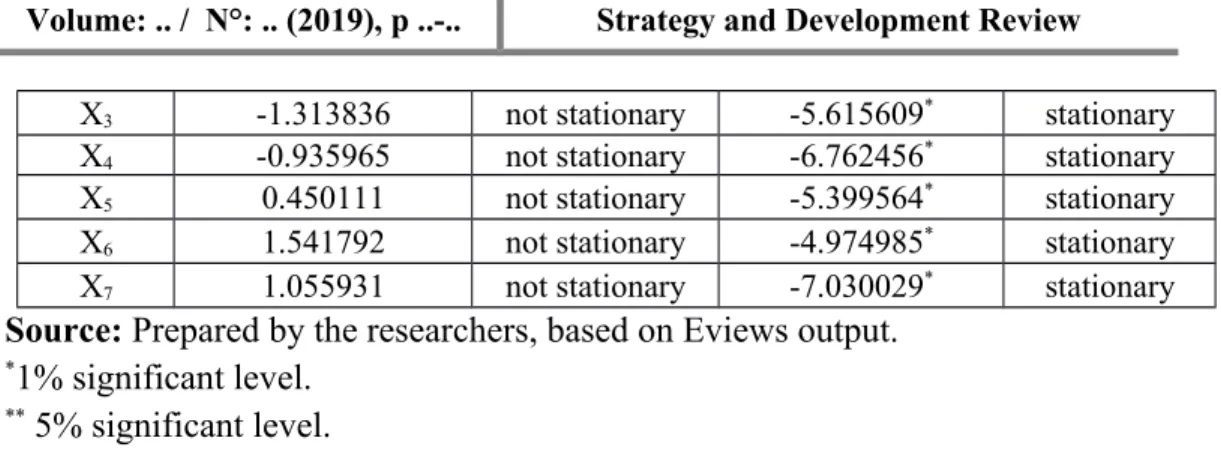Determinants of Foreign Direct Investment Inflows in Algeria An Analytical Econometric Study (1980-2017).
رئازجلا يف رشابملا يبنأجلا رامثتاسلا تاددحم
ةياسايق ةيليلحت ةاسارد
1980
_
2017
Dr. BENCHENNI Abdelkader 1, Dr. BESSADET Karima 2
1 university of Mostaganem, Email: aekkari2202@gimail.com 2 university of Mostaganem, Email: karimaaek@yahoo.fr.
Received: XX ….. 20XX Accepted: XX …… 20XX
Abstract
The study aims to determine the factors that affect the foreign direct investment inflows in Algeria, using a sample of 38 observation for the period 1980-2017.Rely on annual time series and multiple linear regression model to examine the relationship between foreign direct investment inflows as a dependent variable, andmarket size, trade openness, economic stability,credit provided by financial sector,human capital, political stability,quality of infrastructure as independent variables.
The results show that market size, trade openness,human capital have a positive and significant effect on foreign direct investment inflows in Algeria.
Keywords: FDI Inflows, Determinants of FDI, Algeria. JEL Classification: C25, F21
:صخلم
ىلع رثؤتتت يتتتلا لتتماوعلا دتتيدحت ىلإ ةتتساردلا هذتته فدتتهت
ىلع داتتمتعلا مت ،رتتئازجلا وحن رشابملا يبنأجلا رامثتسلا تاقفدت
1
Corresponding author: Benchenni Abdelkader, e-mail: aekkari2202@gimail.com 1
يوتتحت ةتتينمز ةلتتسلس و ددتتعتم يطخ رادحنا جذومن
38
ةدهاتتشم
نم ةرتتتفلا يطغت ةيونتتس
1980
-2017
ىلع ةتتساردلا تدتتمتعا ،
،عباتتت ريغتمك رشابملا يبنأجلا رامثتسلا تاقفدت :ةيلاتلا تاريغتملا
مجح ىلع داتتمتعلا مت دتتقف ةرتتسفملا وأ ةلقتتتسم تاريتتغتمك اتتمأ
ناتتمتئلا ،يداتتصتاقلا رارقتسلا ،يداصتاقلا حاتفنلا ةأجرد ،قوسلا
رارقتتتسلا ،يرتتشبلا لاتتملا سأر،يلاتتملا عاتتطقلا نم مدتتقملا
.ةيتحتلا ىنبلا ةيعون ،يسايسلا
،يداتتصتاقلا حاتتتفنلا ةتتأجرد ،قوسلا مجح نأ ىلإ ةساردلا تلصوت
تاقفدتتت ىلع يوتتنعمو بأجوتتم ريثأتتت اتتهل يرتتشبلا لاتتملا سأر
.رئازجلا يف رشابملا يبنأجلا رامثتسلا
:ةيحاتفم تاملك
تاددحم ،رشابملا يبنأجلا رامثتسلا تاقفدت
.رئازجلا ،رشابملا يبنأجلا رامثتسلا
تافينصت
JEL: C25، F21 1. IntroductionIn the last few years, FDI has an important role in several countries, contributes to realizing economic growth, creates jobs, as a result, reduces unemployment, provides finance, transfer technology, skills and so. Accordingly, countries attempt to attract the larger part of foreign direct investment inflow by improving the investment climate, which requires economic and political stability, unchanging macroeconomic policies, protection of property rights, get better infrastructure, facility access to credit...
Algeria as one of several countries efforts to improve the conditions (economic and policy reforms) to attract big part of foreign direct investment inflow, Algeria has a lot of advantages to draw many investors (proximity to Europe, low cost of energy…), but also has a range of disadvantage such as it is complicated to acquire industrial property, administrative procedures take a long time and slowly, tax law is very complex.
What are the main determinants of FDI inflows in Algeria?
To answer the question we will test the following hypotheses:
GDP per capita is foreign direct investment determinant.
Merchandise trade is foreign direct investment determinant.
Inflation is foreign direct investment determinant.
credit provided by financial sector is foreign direct investment determinant.
School enrollment secondary is foreign direct investment determinants.
Military expenditure is foreign direct investment determinant.
Air transport is foreign direct investment determinant.There are several studies tried to explain the determinants of foreign direct investment, recall the most recent:
Behrooz Shahmoradi, Mostafa Baghbanyan (2011),”Determinants of Foreign Direct Investment in Developing Countries: A Panel Data
Analysis”, based on a sample of 25 developing countries and used panel data techniques to determine the main factors that affect foreign direct investment inflows to this countries for 18 years (1990-2007), the FDI inflows were used as explained variable and FDI outflow, GDP per capita, balance of payment, (export+import)/ GDP, population, mobile telephone per 1000 people, internet users per 1000people, workforce, technology, ODA( Total Official Development Aid, and inflation as explanatory variables. The results achieved that openness of the economy, market size, workforce, ODA, mobile technology, and the internet had a significant and positive effect on FDI inflows, the population had a significant and negative effect, and the other variables did not significantly at any level.[CITATION Beh11 \p 49-56 \l 1036 ]
Yapatake kossele Thales Pacific, Riti Joshua Sunday, Anning Lucy 2015, “Determinants of Foreign Direct Investment Flows to Francophone African Countries: Panel Data Analysis”, to look at the factors that determine foreign direct investment inflows to Francophone African
Countries, they relied on panel data analysis from 25 countries for the period of 9 years(2004-2012) which had 158 panel observations, used FDI inflows as dependent variable and the growth rate of Gross Domestic Product, exports in goods and services, official exchange rate, domestic credit to private sectors, information and communication technology defined by the number of internet users, political stability and absence of violence as independent variables. The main results showed that most important determinants of FDI Francophone African Countries were: exports in goods and services, internet’s users, exchange rate, political stability and absence of violence estimate, the time required to start a business in the country. [CITATION Yap15 \p 4-9 \l 1036 ]
Sobir Shukurov. 2016,”Determinants of FDI in Transition Economics: The Case of CISCountries.” Used panel data models to determine the factors affecting (share of FDI inflows in GDP as dependent variable, and GDP per capita, inflation rate, external balance on goods and services, infrastructure reform, trade and exchange rate restriction, competition policy; banking reforms, natural resources as independent variables )FDI inflows to CIS (Commonwealth Independent States)countries ( Uzbekistan, Ukrraine, Turkmenistan, Tajikistan, Russia, Moldova, Kazakhstan, Belarus, Azerbaijan, Armenia) for the period of 1995-2010. The results indicated that market size, abundance in natural resources were positively affected FDI inflow, where fiscal imbalance and inflation had a negative influence on FDI inflows.[CITATION Shu16 \p 75-94 \l 1036 ]
The study structured as follows: The first part is the introduction to the study. Part two has some background information about foreign direct investment inflow in Algeria. Part three includes the data collection and sources, variable definition, and economic analysis methods. Last part introduces the results of the study. The conclusion and the
recommendations discussed at the end of the study. 2. Overview
Investment is a vital element in development economics and has an important role in several countries alike local or foreign. In recent years nations undertake to care for foreign direct investment since its advantages. Algeria regards as one of the countries that attempt to attract a lot of FDI inflows, thus it seeks to create a favourable and motivate investment climate. Algeria has many potentials to be an attractive country to foreign investments, it riches in natural resources which are competitive factors costs( natural gas 0.21 to 0.40 Euros/therm, electricity 1 to 4 euro certs/kwh on average, gasoline super 0.3euros/ L, gas oil 0.17euros/L)[CITATION htt18 \l 1036 ], has young and a qualified labour force , modern infrastructure, encouragement for investment for example: when foreign company recruits young job seekers, benefits for reduction of charges of contribution to social security (North 56%to 80, Highlands and South 72% to 90%)[ CITATION htt181 \l 1036 ], and so on…
To attract great part of FDI inflows will have identified the mains factors that influence the FDI inflows to Algeria, but before that, we will take a general idea about foreign direct investment in Algeria.
Table and Figure (01) represent foreign direct investment inflows to Algeria from 1970 to 2017, during this period the FDI inflows are increasing, after the independence Algeria did not welcome foreign investments, but now it is realizing its importance as a financing source, so is striving to improve its investment climate to attract more foreign investments. The 1970s showed that FDI inflows during this period have been volatile, but are certainly weak compared to other international sources of finance, in 1971 FDI flows declined to $ 0.6 million compared with 1970 $ 80.12 million (as a result of the liquidation of FDI due to nationalization).The 1980s characterized by the significant decline in foreign direct investment, which reached $ 348.67 million in 1980 to arrive at -53.57 in 1982.In the 1990s, there was a near total absence of foreign direct investment, particularly the period from 1993 to 1995 due to the complex situation in Algeria, As well as the lack of political stability, which had a negative impact on foreign direct investment inflows.From 1996 to 1999 foreign investment inflows had raised, which ranged between
270(1996) and 606.6(1998) million dollars, most of them went to the hydrocarbons sector.Recently the volume of FDI inflows are growing, which reflect the polarization conditions available in Algeria, especially political and institutional stability, improving the macroeconomic framework, and strengthening of infrastructure, as well as government incentives such as finance, fiscal and customs exemption.
Figure N° 1. Foreign Direct Investment inflows to Algeria
.
1970 1978 1986 1994 2002 2010 -1000 -500 0 500 1000 1500 2000 2500 3000 Source: Prepared by researchers, based on data in table N°1.
Table N°1. Foreign Direct Investment inflows to Algeria.
Unit: million dollars
years FDI inflows years FDI inflows
1970 80,12 1994 0.001 1971 0,6 1995 0.001 1972 41,49 1996 270 1973 51 1997 260 1974 358 1998 606,6 1975 119 1999 291,6 1976 187 2000 280,1 1977 178,45 2001 1113.106 1978 135,15 2002 1065 1979 25,69 2003 637.88 1980 348,67 2004 881,85 1981 13,21 2005 1145.33 1982 -53,57 2006 1888.165 1983 0,42 2007 1743.331 1984 0,8 2008 2631.711 1985 0,4 2009 2753.755 1986 5,32 2010 2301.226
1987 3,71 2011 2580.354 1988 13,02 2012 1499.21 1989 12,09 2013 1684 1990 40 2014 1506.733 1991 80 2015 -584 1992 30 2016 1546 1993 0.001 2017 1203 Source :http://unctadstat.unctad.org/wds/TableViewer/tableView.asp /30-6-2018.
Table N°2.The most important countries investing in Algeria (January 2013 – December 2017) Number of companies Number of projects Amount (million dollars ( country 5 10 3539 China 1 3 3151 Singapore 6 10 2565 Spain 4 4 2313 Turkey 7 7 380 Germany 1 1 350 South Africa 10 12 330 France 4 4 330 Switzerland 1 1 232 Italia 2 2 212 United Kingdom 28 28 892 Other 69 82 14293 Total
Source: The Arab Investment and Export Credit Guarantee Corporation, Quarterly Bulletin of Investment Guarantee, Features of Foreign Direct Investment in Arab Countries2017, N02, 2018, p13.
Figure N° 2. The most important countries investing in Algeria
(2013 - 2017).
anihC niapS ynamreG ecnarF ailatI rehtO 0 005 0001 0051 0002 0052 0003 0053 0004
(srallod noillim) tnuomA
Source: Prepared by researchers, based on data in table N°2.
Table and figure (02) display the
most important countries
investing in Algeria from January 2013 to December 2017(China,
Spain, Turkey, Germany,South Africa, France, Switzerland, Italia,
United Kingdom), note that China owns the biggest amount of
investment which achieves to 3539 million dollars, however the
United Kingdom has the lowest amount of investment 212 million
dollars during this period.
Figure N03. The Number of Projects and Companies.
Source: Prepared by researchers, based on data in table N°2 .
Figure N
03 Shows the number of projects and companies for
each country (China, Spain, Turkey, Germany,South Africa, France,
Switzerland, Italia, United Kingdom) during the period of fourth years
from 2013 to 2017, France has biggest number of projects (12
0 5 10 15 20 25 30 Number of projects Number of companies
projects) and companies ( 10 companies), China and Spain have the
same number of projects (10 projects), and 6 companies for Spain and
5 for China, Germany owns 7 projects and companies, when Italia has
the lowest number of projects and companies during this period.
Table N°3. The Top Five Companies Investing in Algeria (January 2013 and December 2017)
Company Country Amount ( Million
Dollars) China State Construction
Engineering Corporation China 3.300
Indorama Singapore 3.151
Grupo Ortiz Construccion y
Servicios Del Mediterraneo Spain 2.209
Tosyali Holding Turkey 1.397
TaypaTekstil Turkey 900
Source: The Arab Investment and Export Credit Guarantee Corporation, Quarterly Bulletin of Investment Guarantee, Features of Foreign Direct Investment in Arab Countries2017, N02, 2018, p13.
Figure N° 4 The Top Five Companies Invested in Algeria (2013 - 2017)
China State Construc-tion Engineering Corpo-ration(China)
Indorama(Singapore)
Grupo Ortiz Con-struccion y Servicios Del
Mediterraneo( Spain)
Taypa Tekstil(Turkey)
Source: Prepared by researchers, based on data in table N°3.
Table (03) represents the top five companies investing in Algeria from 2013-2017, China State Construction Engineering Corporation(CSCEC) which is china’s company invests 3300 million dollars, CSCEC Algeria's business has centered on housing, public works, and infrastructure, Indorama company from Singapore spends 3151 million dollars, Grupo Ortiz Construccion y Servicios Del Mediterraneo(in 2013
the Ortiz Group signed a memorandum of understanding (The contract includes: a train Algerian workers, an architectural and engineering contract for the housing, technology transfer of building systems, construction of concrete panels and slabs in Algiers.) with the Algerian public company OLA to build 5,000 homes using the INDAGSA construction system of precast concrete panels) from Spain its investment arrives at 2209 million dollars, and Turkish company Tosyali Holding invests 1397 million dollars(the ingot produced at Tosyali Algeria is used for the production of wire rod, construction steel, hollow sections, and merchant bars), and Taypa Tekstil 900 million dollars(textile production facility).
Table N°4. Distribution of FDI inflows to Algeria by regions invested (2013-2017)
Investedregions
Amount (million dollars)
%
Asia and the Pacific
6.965
48.7
Western Europe
4.056
28.4
EmergingEuropean
countries
2.328
16.3
Africa
554
3.9
Middle east
317
2.2
NorthAmerica
59
0.4
Latin America and the
Caribbean
13
0.1
Source: The Arab Investment and Export Credit Guarantee Corporation, Quarterly Bulletin of Investment Guarantee, Features of Foreign Direct Investment in Arab Countries2017, N02, 2018, p13.
From table (04) which represents the distribution of FDI inflows
to Algeria by regions invested from 2013 to 2017, note that Asia and
the Pacific have the biggest part of the investment in Algeria 48.7%
as well Western Europe, Emerging European
countries(28.4%,16.3%). When Latin America and the Caribbean
have the little part of investment 0.1%, also Africa, Middle East,
North America doesn’t have a big contribution for FDI inflows (3.9%,
2.2%, and 0.4%).
Figure N° 5. Distribution of FDI inflows to Algeria by regions invested (2013-2017)
Asia and the Pacific Western Europe
Emerging European coun-tries
Africa Middle east North Amarica
Latin America and the Car-ibbean
Source: Prepared by researchers, based on data in table N°4.
3. The Methodology and Data Description 3.1Methodology
3.1. Nature and sources of data
To determine the main factors that affect foreign direct investment in Algeria and test the hypotheses, the annual data were collected from theNational Agency of Investment Development ( ANDI),United Nations Conference on Trade and Development(UNCTAD), The Arab Investment & Export Credit Guarantee Corporation (Dhaman) for the period 1980 to 2017. The study uses annual time series data consists 38 observation, including foreign direct investment inflows, GDP per capita, Merchandise
trade, inflation, credit provided by financial sector, School enrollment secondary, Military expenditure, Air transport.
Table (05) represents the determinants of FDI inflows, their name, definition and the expected effect on FDI inflows.
Table N°5. Variables Description
Variables name definition Expectedsin
g GDP per capita ( market size)
GDP per capita is gross domestic product divided
by total population.
Positive Merchandise trade (openness of
economy)
Export plus import divided by the value of
GDP.
positive
Inflation ( economicstability)
Inflation as measured by the consumer price index
reflects the annual percentage change in the
cost to the average consumer of acquiring a
basket of goods and services that may be fixed or changed at
specified intervals.
Negative
Domestic credit provided by financial sector
Domestic credit provided by the financial sector
includes all credit to various sectors on a gross basis, with the exception of credit to the
central government, which is net.
Positive
School enrollment secondary( human capital)
The ratio of total enrolment, regardless of age, to the population of
the age group that
officially corresponds to the level of education
shown.
Militaryexpenditure( politicalstability )
Military expenditures include all current and capital expenditures on
the armed forces.
Positive
Air transport( quality of infrastructure)
Registered carrier departures worldwide are
domestic takeoffs and takeoffs abroad of air carriers registered in the
country.
Positive
Source: Prepared by the researchers, based on https://data. worldbank. org/ products/ wdi/ 25/07/2018.
4. Hypothesis and model specifications
The study attempts to test the following hypotheses:
GDP per capita, Merchandise trade, Inflation, credit provided by financial sector, School enrollment secondary, Military expenditure and Air transport are foreign direct investment determinants.
Multiple regression model is used to find the main determinants of foreign direct investment inflows in Algeria, according to the prevision studies and Literature Review we develop the following basic model:
FDI= f(
market size, openness of economy, economic stability, domestic credit provided by financial sector,human capital, political stability,quality of infrastructure)FDI= B
0+ B
1X
1+B
2X
2+B
3X
3+B
4X
4+B
5X
5+B
6X
6+B
7X
7Where:
FDI: foreign direct investment inflows, X
1:
GDP per capita (market(economic stability)
, X
4:
credit provided by financial sector,X
5:
Schoolenrollment secondary (human capital)
, X
6:
Military expenditure (politicalstability),
X
7:
Air transport (quality of infrastructure)4. Results and Discussion 4.1 unit of root test
The stationary time series require that: The mean of Yt is constant over time:
E (Yt) = Y
The variance of Yt is constant over time:
The covariance of time series does not vary over time and depend on the factor of time only. But sometimes the non stationary is obtained because of the changes that face economic environment as the result of the economic fluctuations (business cycle fluctuation between expansion and recession), in this case the test statistics may often show a significant relationship between variables in the regression model even though no such relationship exists between them and this creates incorrect regression even when the value of R2 is high. To investigate this problem, the ADF
(Augmented Dickey-Fuller) test of stationary is used which is the most widely used unit root test. After computed the value of Dickey-Fuller, we compared this value with the critical value tabulated by Dickey-Fuller (the Dickey-Dickey-Fuller test), if the value of the former is greater than the value of later the null hypothesis is rejected which mean that times series is stationary, if not the null hypothesis is accepted, that is times series is nonstationary. In this case, the first difference of data is taken and retesting, even the times series is stationary. [CITATION Dic79 \p 429 \l 1036 ]
Table N°6. Unit Root Test variable
s
level 1stdifference
ADF test statistic Result ADF test statistic Result
y -1.190294 not stationary -2.335862** stationary
X1 0.311196 not stationary -5.491112* stationary
X3 -1.313836 not stationary -5.615609* stationary
X4 -0.935965 not stationary -6.762456* stationary
X5 0.450111 not stationary -5.399564* stationary
X6 1.541792 not stationary -4.974985* stationary
X7 1.055931 not stationary -7.030029* stationary
Source: Prepared by the researchers, based on Eviews output. *1% significant level.
** 5% significant level.
This work started with the null hypothesis that the variables of interest in the study have a unit root (that is nonstationary) against the alternative hypothesis that the variables are stationary. The test for this null hypothesis has represented in a table (06), we can see that all variables are not stationary at the level so they have a unit root, thus we accept the null hypothesis. After taking first difference they became stationary at 1% and 5% significant level.
4.2 Johansen Cointegration Test
Cointegration analysis is used to investigate the long-term relationship between the variables (FDI, market size, openness of economy, economic stability,credit provided by financial sector,human capital, political stability, andquality of infrastructure) of the study. Economically speaking two variables will be cointegration if they have long-term or equilibrium relationship between them. To look for this relationship Johansen test is used to test the null hypothesis that says there is no cointegration between the variables of the study against the alternative that says there is cointegration between the variables of the study.[CITATION Joh92 \p 230 \l 1036 ]
Table N°7. Cointegration Test Hypothesized N0.of
CE(s) Trace Statistic 0.05critical value prob
None* 199.950 159.5297 0.0000
At most 1* 133.9974 125.6154 0.0139
At most 2* 99.90256 95.75366 0.0251
At most 4 40.87110 47.85613 0.1928
At most 5 22.04305 29.79707 0.2961
At most 6 10.09333 15.49471 0.2736
At most 7 0.244073 3.841466 0.6213
Source: Prepared by the researchers, based on Eviews output. *denote rejection of the hypothesis at the 0.05 level
Table(07) represents the Cointegration test results, as we see there are three Cointegration at a level of 5%, which means there is a long-term relationship between the FDI, market size, openness of economy, economic stability,credit provided by financial sector,human capital, political
stability, andquality of infrastructure. Thus we reject the null hypothesis that says there is no cointegration between the variables of the study, and accept the alternativehypothesis that saysthere is cointegration between the variables of the study.
Table N°8. Regression Result
Dependent variable : y
variable Coefficient t- statistic prob
c -2239.682 -2.468621 0.0195 X1 0.300808 3.181898 0.0034 X2 34.95256 3.145034 0.0037 X3 -20.85225 -1.600169 0.1200 X4 -0.001734 -0.034345 0.9728 X5 15.57672 2.729320 0.0105 X6 -246.0105 -1.685805 0.1022 X7 0.004695 0.257049 0.7989 F-statistic 11.92350 R-squared 0.735600 Prob
(F-statistic) 0.000000 Adjusted R-squared 0.673907 Source: Prepared by the researchers, based on Eviews output.
The results show that market size, openness of economy, capital human have a positive and significant (1%, 1%, 5%, respectively) effects on foreign direct investment inflows in Algeria, where inflation, credit
provided by financial sector, Military expenditure have negative effects on FDI inflows, but are not significant at any level, also Air transport as a proxy of infrastructure has a positive effect on FDI inflows but is not significant at any level. GDPper capita as an indicator for market size has a positive and significant effect on foreign direct investment inflows at a level of 1%, this means that Algeria foreign direct investment inflows will increase by
0.300808
if GDPper capita raises by a unit. So market size is an important determinant of FDI inflows in Algeria, a higher GDP per capita means higher effective demand and purchasing power, the literature confirms that market size is an important determinant of FDI inflows in the host country[CITATION Sin95 \p 14 \l 1036 ],[CITATION Cul88 \p 885-904 \l 1036 ], [CITATION Lia12 \p 327 \l 1036 ].Merchandise trade as proxy for openness of economy has a positive and significant relationship with Algeria foreign direct investment inflows at a level of 1%, this result is consistent with previous studies[CITATION Moo06 \p 199-211 \l 1036 ], [CITATION Cha10 \p 533 \l 1036 ] ، [CITATION Sri11 \p 26 \l 1036 ], thus trade openness is an essential determinant of FDI inflows in Algeria, foreign investors are more attracted to countries that opened up to the outside world, a high value indicates openness to trade, and it is a motivating factor for foreign investors. [ CITATION Cav96 \l 1036 ]. Capital human has positive and significant relationshipswith Algeria foreign direct investment inflows at level 5%, which means that well-informed labor force in host country attracting more FDI inflows.[CITATION Asi06 \p 63 \l 1036 ]. Air transport indicates the quality of infrastructure is found to be insignificant, this means that quality of infrastructure is not determinant of Algeria foreign direct investment inflows, this result is supported by Quazi[CITATION Qua07 \p 329 \l 1036 ], in addition inflation[CITATION Eli08 \p 22 \l 1036 \m Asi06 \m Asi06], credit provided by financial sector (Yapatake kossele Thales Pacific, Riti Joshua Sunday, Anning Lucy2015) and military expenditure have negative and non-significant impact on FDI inflows in Algeria.
5. Conclusions
Currently, the countries compete to attract great part of foreign investment inflows for the reason that it makes jobs, improve economic growth, provides stable finance and so. Algeria also aims to attract more foreign investment inflows by improving its investment climate. The first part in this study was an overview on foreign direct investment inflows in Algeria from 1970 o 2017, during this period the FDI inflows are increasing as result of improving its investment climate, the most important countries investing in Algeria from 2013 to 2017 are China, Spain, Turkey,
Germany,South Africa, France, Switzerland, Italia, and United Kingdom, while the top five companies investing in Algeria from 2013-2017are China State Construction Engineering Corporation(CSCEC, Indorama company from Singapore , Grupo Ortiz Construccion y Servicios Del Mediterraneo from Spain, and Turkish companies Tosyali Holding. and Taypa Tekstil, the distribution of FDI inflows to Algeria by regions invested from 2013 to 2017, note that Asia and the Pacific have the biggest part of the investment in Algeria when North America has the lowest contribution for FDI
inflows. In the second part, we investigated whether the GDP per capita, Merchandise trade, inflation, credit provided by financial sector, School enrollment secondary, Military expenditure and Air transport affect foreign direct investment inflows in Algeria, rely on time series include a sample of 38 observation from 1980 to 2017.
Finally, the results showed that GDP per capita as a proxy of market size, Merchandise trade as an indicator of economic openness, andSchool enrollment secondary as a proxy of capital human are important attracting factors of FDI inflows in Algeria.
Bibliography Liste:
Asiedu, E. (2006). “Foreign Direct Investment in Africa: The Role of Natural Resources, Market Size, Government Policy, Institutions and Political Instability”. World Econ, volume 29, issue (1)
Asiedu, E. (2006). “Foreign Direct Investment in Africa: The Role of Natural Resources, Market Size, Government Policy, Institutions and Political Instability”. World Econ, volume 29, issue (1)
1.
Behrooz Shahmoradi, Mostafa Baghbanyan (2011). “Determinants of Foreign Direct Investment in Developing Countries: A Panel Data Analysis”. Asian Economic and Financial Review, vol. 1, issue 2.2.Asiedu, E. (2006). “Foreign Direct Investment in Africa: The Role of Natural Resources, Market Size, Government Policy, Institutions and Political Instability”. World Econ, volume 29, issue (1)
3.
4.Caves, R. (1996). “ Multinational Firms and Economic Analysis”. Cambridge University Press, 2nd edition, Cambridge and New York. 5.Chantasasawat, B., Fung, K. C., Iizaka, H., & Siu, A. (2010). ” FDI flows
to Latin America, East and Southeast Asia, and China: Substitutes or complements”. Review of DevelopmentEconomics, 14(3).
6.Culem, C.G. (1988). “The locational determinants of direct investment among industrialized countries”. EuropeanEconomicReview, 32(3). 7.Dickey, D., and Fuller, W. (1979), “Distributions of the Estimators for
Autoregressive time Series with a Unit Root”. Journal of American Statistical Association,.
8.Elijah, U. Festus, O. (2008). “Exchange Rate Volatility, inflation uncertainty and Foreign Direct Investment in Nigeria”. BOJE:
Botswana Journal of Economic. Vol (5). No 7.
9.Johansen, S., and Juselius, K., (1992). “Testing Structural Hypotheses in a Multivariate Cointegration Analysis at the Purchasing Power Parity and the Uncovered Interest Parity for the UK”. Journal of Econometrics, 53. 10.Liargovas, P.G.; Skandalis, K.S. (2012). “Foreign Direct Investment and
Trade Openness: The Economies”. Social IndicatorsResearch, 106(2). 11.Moosa, I. A. & Cardak, B. A. (2006). “The determinants of foreign direct
investment: An extreme bounds analysis”. Journal of Multinational Financial Management, 16(2).
12.Quazi, R. (2007). “Economic freedom and foreign direct investment in East Asia”. Journal of the Asia Pacific Economy, 12(3).
13.Singh, H. & Jun, K.W. (1995). “Some new evidence on determinants of foreign direct investment in developing countries”. Policy Research working Paper N01531. Washington, DC:
WorldBank.http://documents.worldbank.org/curated/en/266321
468766524774/Some-new-evidence-on-determinants-of-foreign-direct-investment-in-developing-countries
14.Sobir Shukurov (2016). “Determinants of FDI in Transition Economics: The Case of CIS Countries.” Journal of International and Global EconomicStudies, 9(1).
15.
Yapatake kossele Thales Pacific, Riti Joshua Sunday, Anning Lucy (2015). “Determinants of Foreign Direct Investment Flows to Francophone African Countries: Panel Data Analysis”. Journal of Economics Sustainable Development, ISSN2222-1700(Paper) ISSN 2222-2855(Online), Vol.6, No.13, www.iiste.org.Web Sites
- http://www.andi.dz/index.php/en/raisons-pour-investir. ( consulted on 21/07/2018
)
- http://unctadstat.unctad.org/wds/TableViewer/tableView.asp (consulted on30/6/2018
)
- The Arab Investment and Export Credit Guarantee Corporation, Quarterly Bulletin of Investment Guarantee, Features of Foreign Direct Investment in Arab Countries2017, N02, (consulted on 25/07/2018)
- http://dhaman.net/en/research-studies/annual-report-latest(consulted

